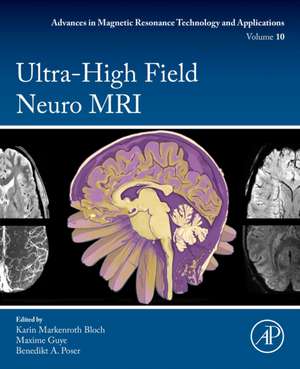Ultra-High Field Neuro MRI: Advances in Magnetic Resonance Technology and Applications, cartea 10
Editat de Karin Markenroth Bloch, Maxime Guye, Benedikt A. Poseren Limba Engleză Paperback – 22 aug 2023
- Presents the opportunities and technical challenges presented by MRI at ultra-high field
- Describes advanced ultra-high field neuro MR techniques for clinical and neuroscience applications
- Enables the reader to critically assess the specific UHF advantages over currently available techniques at clinical field strengths
Preț: 801.68 lei
Preț vechi: 1187.90 lei
-33% Nou
Puncte Express: 1203
Preț estimativ în valută:
153.42€ • 157.12$ • 127.62£
153.42€ • 157.12$ • 127.62£
Carte tipărită la comandă
Livrare economică 12-26 martie
Livrare express 11-15 februarie pentru 202.44 lei
Preluare comenzi: 021 569.72.76
Specificații
ISBN-13: 9780323998987
ISBN-10: 0323998984
Pagini: 626
Ilustrații: 105 illustrations (25 in full color)
Dimensiuni: 191 x 235 x 34 mm
Greutate: 1.06 kg
Editura: ELSEVIER SCIENCE
Seria Advances in Magnetic Resonance Technology and Applications
ISBN-10: 0323998984
Pagini: 626
Ilustrații: 105 illustrations (25 in full color)
Dimensiuni: 191 x 235 x 34 mm
Greutate: 1.06 kg
Editura: ELSEVIER SCIENCE
Seria Advances in Magnetic Resonance Technology and Applications
Cuprins
Part 1: Benefits of Ultra-High Field
1. The way back and ahead: MR physics at Ultra-High Field
2. Translating UHF advances to lower field strength
Part 2: Acquisition at Ultra-High Field: practical considerations
3. Practical solutions to practical constraints: Making things work at ultra-high field
4. Practical considerations on ultra-high field safety
5. Bioeffects, patience experience and occupational safety
Part 3: Ultra-High Field Challenges and Technical Solutions
6. B0 inhomogeneity: Causes and coping strategies
7. B1 inhomogeneity: Physics background, RF pulse design and parallel transmission
8. RF coils for ultra-high field neuroimaging
9. Parallel imaging and reconstruction techniques
10. Motion correction
Part 4: Ultra-high field Structural Imaging: Techniques for neuroanatomy
11. High-resolution T1-weighted and T2-weighted anatomical imaging
12. Brain segmentation at ultra-high field: challenges, opportunities and unmet needs
13. Phase imaging: Susceptibility-weighted imaging and Quantitative Susceptibility Mapping
14. Quantitative MRI and multi-parametric mapping
Part 5: Ultra-high field Structural Imaging: Zooming in on the brain
15. Cerebellar imaging
16. Ultra-high field imaging of the medial temporal lobe
17. Imaging of the deep gray matter
18. Brain stem imaging
19. Spinal Cord Imaging
Part 6: Diffusion and Perfusion imaging at Ultra-High Field
20. Diffusion weighted magnetic resonance at ultra-high field
21. Ultra-high Field Brain Perfusion MRI
Part 7: Ultra-High Field Functional Imaging
22. BOLD fMRI: physiology and acquisition strategies
23. Sequences and contrasts for non-BOLD fMRI
24. Laminar and columnar imaging at UHF: considerations for mesoscopic scale imaging with fMRI
25. The power of gray-matter optimized fMRI at UHF for cognitive neuroscience
Part 8: Techniques for Ultra-High Field Metabolic Imaging and Spectroscopy
26. MR Spectroscopy and spectroscopic imaging
27. Imaging with X-nuclei
28. Chemical Exchange Saturation Transfer MRI in the human brain at ultra-high fields
Part 9: Benefits of Ultra-High Field in Clinical Applications
29. Epilepsy
30. Multiple sclerosis
31. Neurovascular diseases
32. Neurodegenerative diseases
33. Parkinson’s disease and Parkinson-plus syndromes
34. Alzheimer's disease and ageing
35. Oncological applications
36. Psychiatric applications at UHF
Part 10: New Horizons
37. Human MR at extremely high field strengths
1. The way back and ahead: MR physics at Ultra-High Field
2. Translating UHF advances to lower field strength
Part 2: Acquisition at Ultra-High Field: practical considerations
3. Practical solutions to practical constraints: Making things work at ultra-high field
4. Practical considerations on ultra-high field safety
5. Bioeffects, patience experience and occupational safety
Part 3: Ultra-High Field Challenges and Technical Solutions
6. B0 inhomogeneity: Causes and coping strategies
7. B1 inhomogeneity: Physics background, RF pulse design and parallel transmission
8. RF coils for ultra-high field neuroimaging
9. Parallel imaging and reconstruction techniques
10. Motion correction
Part 4: Ultra-high field Structural Imaging: Techniques for neuroanatomy
11. High-resolution T1-weighted and T2-weighted anatomical imaging
12. Brain segmentation at ultra-high field: challenges, opportunities and unmet needs
13. Phase imaging: Susceptibility-weighted imaging and Quantitative Susceptibility Mapping
14. Quantitative MRI and multi-parametric mapping
Part 5: Ultra-high field Structural Imaging: Zooming in on the brain
15. Cerebellar imaging
16. Ultra-high field imaging of the medial temporal lobe
17. Imaging of the deep gray matter
18. Brain stem imaging
19. Spinal Cord Imaging
Part 6: Diffusion and Perfusion imaging at Ultra-High Field
20. Diffusion weighted magnetic resonance at ultra-high field
21. Ultra-high Field Brain Perfusion MRI
Part 7: Ultra-High Field Functional Imaging
22. BOLD fMRI: physiology and acquisition strategies
23. Sequences and contrasts for non-BOLD fMRI
24. Laminar and columnar imaging at UHF: considerations for mesoscopic scale imaging with fMRI
25. The power of gray-matter optimized fMRI at UHF for cognitive neuroscience
Part 8: Techniques for Ultra-High Field Metabolic Imaging and Spectroscopy
26. MR Spectroscopy and spectroscopic imaging
27. Imaging with X-nuclei
28. Chemical Exchange Saturation Transfer MRI in the human brain at ultra-high fields
Part 9: Benefits of Ultra-High Field in Clinical Applications
29. Epilepsy
30. Multiple sclerosis
31. Neurovascular diseases
32. Neurodegenerative diseases
33. Parkinson’s disease and Parkinson-plus syndromes
34. Alzheimer's disease and ageing
35. Oncological applications
36. Psychiatric applications at UHF
Part 10: New Horizons
37. Human MR at extremely high field strengths












